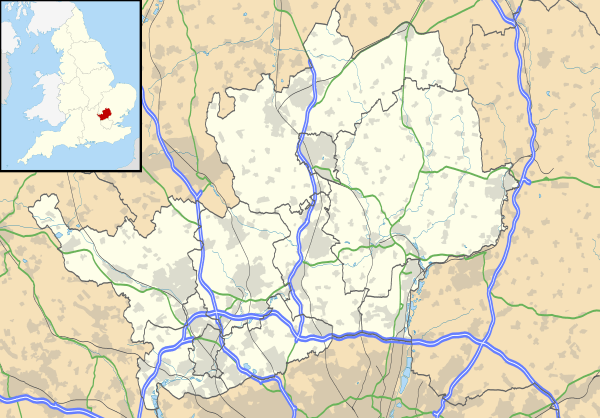Cow Roast
Cow Roast is a small hamlet in the civil parish of Wigginton, Hertfordshire, England. It is located between Tring and Berkhamsted along the A4251 and nearby Grand Union Canal. It is in the civil parish of Northchurch. Today it comprises a row of 20th century cottages and a marina, together with one or two older properties including a public house. There are also three car dealerships beside the main road.
| Cow Roast | |
|---|---|
 The Cow Roast Inn, Cow Roast | |
 Cow Roast Location within Hertfordshire | |
| OS grid reference | SP958103 |
| District | |
| Shire county | |
| Region | |
| Country | England |
| Sovereign state | United Kingdom |
| Post town | Tring |
| Postcode district | HP23 |
| Dialling code | 01442 |
| Police | Hertfordshire |
| Fire | Hertfordshire |
| Ambulance | East of England |
| UK Parliament | |
Cow Roast is on the site of a Romano-British settlement close to the route of Akeman Street.
Origin of the name
The name Cow Roast is almost certainly a corruption of the name "Cow Rest" indicating a place where there were pens and grazing to rest cattle being driven to market. The hamlet lies on an ancient drovers route through the Chiltern Hills towards London.[1]
History
Archaeological evidence suggest that the area was the centre of, for its time, a major extraction, smelting and trade of bog iron in Iron Age Britain.[2]
Cow Roast is the site of a Romano-British settlement which was set up close to the route of Akeman Street. The 'Berkhamsted and District Archaeological Society' began excavation in 1972, work began in an orchard nearby the 'Cow Roast Inn' for four years and for three years at the Marina; excavation then later expanded to the land adjacent to that of the 'Cow Roast Inn'. The excavation led to the discovery of a number of different Roman artifacts which led to the area subsequently being registered as an ancient monument under the protection of English Heritage and is designated as a Roman town.[3]
The excavation in Cow Roast led to the discovery of a number of objects both big and small. Smaller finds included a variety of crafted objects such as coins, tools and jewelry made from iron, bronze, stone, shale glass and even bone. Larger findings included 14 well shafts which due to the significant number suggests industrial water usage; likely for the purpose of iron production. Complementing this a large amount of iron slag and cinder were discovered at the Marina site. Further discovery included remains of beam slots and post holes from wooden buildings in addition to that were also the remains of flint masonry walls.[4]
Around the area of the excavation a number of different bones were found from a variety of animals however the most commonly found bones were that of cows with over 40 being discovered. This is likely due to it being used as a drovers' route so that cattle could be taken to London to provide meat; the cows and their drivers would rest overnight before continuing their journey onward. The current name "Cow Roast" is believed to have come from the corruption of its original name "Cow Rest".[1]
Cow Roast has been described by Dacorum Borough Council as “one of the most important Late Iron Age and Roman industrial landscapes in England” despite being almost completely unknown and unexploited by tourism.[5]
Archeological finds suggest it was occupied as late as the 5th Century, although the byway through the Chiltern Hills would have been an important conduit throughout the Roman occupation. Subsequently, it was known as a drovers' route with the area around the present day Cow Roast providing grazing.
During the construction of the nearby Grand Union Canal including a lock in 1813 a bronze helmet was discovered. The present day Cow Roast pub was built around 1800 on the site of the previous toll gate erected when the Sparrows Herne turnpike road was improved in the 1760s. Cow Roast Marina opened for business in 1996. The A41 Berkhamsted to Tring road passed by Cow Roast until the bypass was opened in 2004.[6]
 Cow Roast is situated on the A4251 road, the Grand Union Canal and the west coast main line.
Cow Roast is situated on the A4251 road, the Grand Union Canal and the west coast main line. The Grand Union Canal lock at Cow Roast
The Grand Union Canal lock at Cow Roast Diesel-hauled freight under the 25 kV wires on the West Coast Main Line at Cow Roast footbridge, near Tring.
Diesel-hauled freight under the 25 kV wires on the West Coast Main Line at Cow Roast footbridge, near Tring.
Geography
Cow Roast is situated between two towns named Tring and Berkhamsted and sits alongside the Grand Union Canal.
References
- Hertfordshire Genealogy (Cow Roast)
- Copeland, Tim, Akeman Street, The History Press, 2009. ISBN 9780752447322
- English Heritage Register Archived 2013-04-23 at Archive.today
- The Cow Roast Dig Archived 2013-04-23 at Archive.today
- Tring Living (Cow Roast)
- Cow Roast (A Guide to Old Hertfordshire)